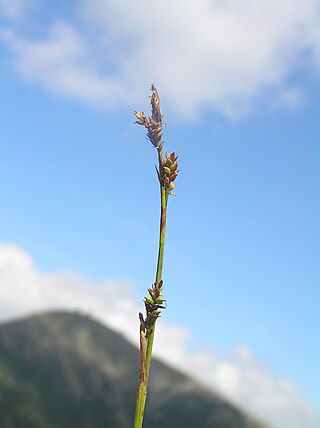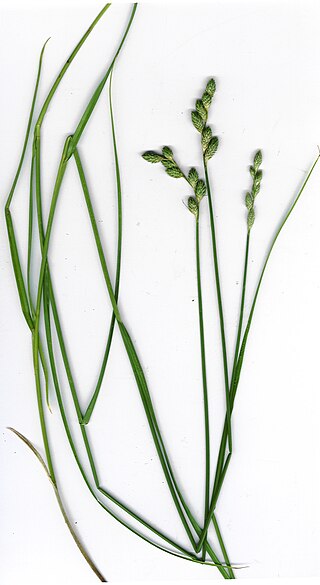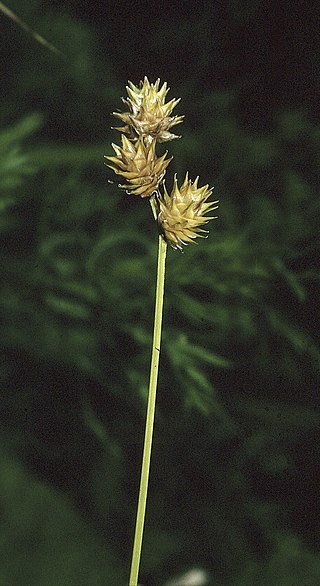
Carex nigra is a perennial species of plants in the family Cyperaceae native to wetlands of Europe, western Asia, north Africa, and eastern North America. Common names include common sedge, black sedge or smooth black sedge. The eastern limit of its range reaches central Siberia, Turkey and probably the Caucasus.

Carex spissa is a species of sedge known by the common name San Diego sedge. It is native to the southwestern United States in California, Arizona, and New Mexico, and far northern Mexico. It grows in wet places such as seeps and streambanks, sometimes on serpentine soils. This sedge looks somewhat like a cattail. It produces angled stems easily exceeding a meter in height surrounded by leathery green to reddish leaves up to about 1.2 meters long. The inflorescence is up to 80 centimeters long, with many long reddish brown flower spikes, each holding up to 300 developing fruits.

Carex bigelowii is a species of sedge known by the common names Bigelow's sedge, Gwanmo sedge, and stiff sedge. It has an Arctic–alpine distribution in Eurasia and North America, and grows up to 50 centimetres (20 in) tall in a variety of habitats.

Carex vaginata is a species of sedge known by the common name sheathed sedge.

Carex eburnea, known as ivory sedge, ebony sedge, and bristleleaf or bristle-leaved sedge, is a small and slender sedge native to North America, from Alaska and Newfoundland south to central Mexico.

Carex longii, or Long's sedge, is a species of sedge found in North America that was first described by Kenneth Mackenzie in 1922.

Carex bromoides, known as brome-like sedge, brome-sedge, and dropseed of the woods, is a species of sedge in the genus Carex. It is native to North America.

Carex woodii, known as pretty sedge, is a species of sedge native to North America.

Carex bicknellii, known as Bicknell's sedge and copper-shouldered oval sedge, is a species of sedge native to North America. Carex bicknellii grows in small clumps with fewer than 25 flowering stems per clump. It is found in mesic to dry prairies, savannas, and open woodlands.
Carex albolutescens, known as greenish-white sedge or greenwhite sedge is a species of sedge native primarily to the lower Midwest and Eastern United States. C. albolutescens grows in wetlands, with an affinity toward acidic soils in swamps and woodlands.

Carex bebbii, Bebb's sedge, is a species of sedge native to the northern United States and Canada. Carex bebbii grows in a variety of wetland habitats such as lakeshores, streambanks, ditches, meadows, swamps, and seeps. It forms dense tufts with culms up to 90 centimeters tall.

Carex tenera, known as quill sedge, is a species of sedge native to the northern United States and Canada.

Carex brevior, known as shortbeak sedge and plains oval sedge, is a species of sedge native to North America. The specific epithet brevior means "shorter" in Latin.

Carex silicea, known as beach sedge, is a species of sedge native to North America. It is found in the northeastern United States and southeastern Canada.
Carex stenoptila, known as riverbank sedge, is a species of sedge native to North America.

Carex straminea, known as eastern straw sedge, is a species of sedge native to North America.
Carex suberecta, known as prairie straw sedge, is a species of sedge native to North America.

Carex capillaris, the hair-like sedge, is a species of sedge found in North America and northern Eurasia including Greenland.

Carex viridula, known as little green sedge, green sedge, or greenish sedge, is a small flowering plant native to North America, Europe, Asia, and Morocco.
Carex deweyanaDewey's sedge, short-scale sedge, is a species of sedge native to Canada and the United States.

















